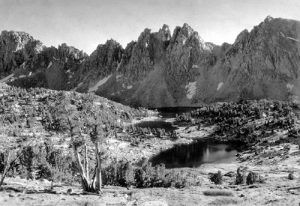Mining Above the Timberline – Legends of America (original) (raw)
By William Daugherty, 1891
Kearsarge Pinnacles
On Mt. Kearsarge, one of the high peaks of the Sierras in Inyo County, California, and near its summit, at an elevation of 13,000 feet above sea level, is located a gold mine that was known some years ago as the Rex Montez. It was far above the timberline in the region of perpetual snow. Consequently, it was pretty expensive to work for all supplies transported on pack mules, including wood for domestic purposes, while water was obtained from melted snow. The boarding and lodging houses were made comfortable, for during the winter for three and four months, the miners were cut off from all communication with the town of Independence, only eight miles distant and in plain sight from the mine. Work, however, was prosecuted nearly as well in winter as at any time, for even in August, the mine’s tunnels and drifts were like refrigerators, as their walls were covered with ice all the year through. The mill was at the foot of the main peak, five miles down, and was run only in the summer when the pack trail was open.
Occasionally, men would venture down from the mine in the winter, but the descent was so dangerous and the return so difficult and full of danger that this was a rare event. On one occasion, a Chinese cook employed at the mine, trying to make the descent to celebrate China New Year’s in Independence, was lost and perished in the snow. His body was not found until summer when a miner descending by a shortcut found it frozen in a snowbank in a deep ravine. The Chinese of Independence had made efforts to find the body and had offered a reward of 500toanyonewhowouldproduceit.Thefinderdugitoutofthesnow,carrieditdownsomedistance,andhiditinthebrush.Thenhewentintotownandclaimedthereward,whichtheChinamencouldnotpayfromsomefinancialstress.Hedidnotlosemuchtimenegotiatingandhurriedmatterstoaconclusionbytellingthemthebodywashiddenonthesunnyslopeandwouldsoonthawout.Thatcausedthemtohustlearound,andtheyraised500 to anyone who would produce it. The finder dug it out of the snow, carried it down some distance, and hid it in the brush. Then he went into town and claimed the reward, which the Chinamen could not pay from some financial stress. He did not lose much time negotiating and hurried matters to a conclusion by telling them the body was hidden on the sunny slope and would soon thaw out. That caused them to hustle around, and they raised 500toanyonewhowouldproduceit.Thefinderdugitoutofthesnow,carrieditdownsomedistance,andhiditinthebrush.Thenhewentintotownandclaimedthereward,whichtheChinamencouldnotpayfromsomefinancialstress.Hedidnotlosemuchtimenegotiatingandhurriedmatterstoaconclusionbytellingthemthebodywashiddenonthesunnyslopeandwouldsoonthawout.Thatcausedthemtohustlearound,andtheyraised250, which they tendered, and the miner finally accepted and proceeded to deliver the goods at once. The bones were, in due time, sent to China. The miner went on a spree that ended sometime after his shooting and killing of the Sheriff. He was duly tried and sentenced to death but escaped that fate by being adjudged insane, and years after, this writer saw him in the Stockton Asylum. The cunning leer of recognition he gave indicated some “method in his madness.”
By William Daugherty, Reno Evening Gazette, March 11, 1891. Compiled and edited by Kathy Alexander/Legends of America, updated January 2023.
Also See:
Mining on the American Frontier
Pioneers on the Nevada Frontier (Reno Evening Gazette)
About the Author: Written by William Daugherty for the Reno Evening Gazette in 1891. The Reno Evening Gazette was first published on October 12, 1876, and continued for 107 years. In 1977, it was merged with the Nevada State Journal and continues to exist today as the Reno Gazette-Journal. Note: The article is not verbatim as spelling errors, minor grammatical changes, and editing have occurred for the ease of the modern reader.
